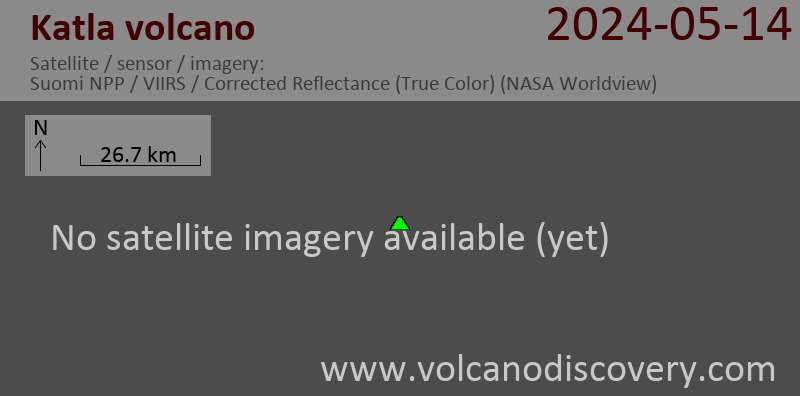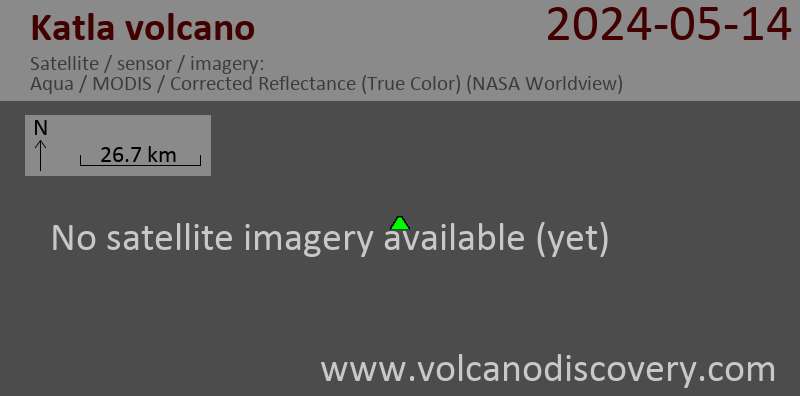Katla Volcano
Katla volcano, located near the southern end of Iceland's eastern volcanic zone, is hidden beneath the Myrdalsjökull icecap. Katla is one of Iceland's most active and most dangerous volcanoes, infamous for its large eruptions happening on average every 50-100 year, causing devastating glacial floods (jökullhlaups).
In recent year, increased seismicity and inflation of Katla has been being measured. Katla, statistically due for a new eruption, is being very closely monitored and an eruption in a not too distant future would not come as a big surprise.
Katla volcano eruptions: 920 AD, 950 AD (?), 1150, 1177, 1245, 1262, 1311, 1357, 1416, 1440, 1450, 1500, 1580, 1612, 1625, 1660-61, 1721, 1755-56, 1823, 1860, 1918, 1955(?), 1999(?)
Latest nearby earthquakes
| Date and Time | Mag / Depth | Distance / Location | |||
|---|---|---|---|---|---|
| Nov 19, 08:15 am (Reykjavik) | 0.8 1.1 km | 4 km (2.5 mi) to the S | Info | ||
| Nov 19, 05:37 am (Reykjavik) | 0.8 23 km | 0.8 km (0.5 mi) to the SW | Info | ||
| Tuesday, November 18, 2025 GMT (1 quake) | |||||
| Nov 18, 09:02 am (Universal Time) | 0.8 0.1 km | 3.9 km (2.4 mi) to the SW | Info | ||
| Monday, November 17, 2025 GMT (2 quakes) | |||||
| Nov 17, 08:14 am (Reykjavik) | 0.1 1.1 km | 5 km (3.1 mi) to the W | Info | ||
| Nov 17, 08:14 am (Universal Time) | 0.8 0.1 km | 4 km (2.5 mi) to the W | Info | ||
| Sunday, November 16, 2025 GMT (1 quake) | |||||
| Nov 16, 11:16 am (Universal Time) | 0.7 0.1 km | 5.3 km (3.3 mi) to the S | Info | ||
| Saturday, November 15, 2025 GMT (1 quake) | |||||
| Nov 15, 04:09 pm (Universal Time) | 0.7 0 km | 6.2 km (3.8 mi) to the NW | Info | ||
| Thursday, November 13, 2025 GMT (1 quake) | |||||
| Nov 13, 05:40 pm (Reykjavik) | 1.3 0.1 km | 0.4 km (0.3 mi) to the SW | Info | ||
| Tuesday, November 11, 2025 GMT (1 quake) | |||||
| Nov 11, 04:07 pm (Reykjavik) | 1.2 0.1 km | 22 km (14 mi) to the W | Info | ||
Background
The subglacial dominantly basaltic volcano is one of Iceland's most active and is a frequent producer of damaging jökulhlaups, or glacier-outburst floods. A large 9 x 14 km subglacial caldera with a long axis in a NW-SE direction is up to 750 m deep. Its high point reaches 1380 m, and three major outlet glaciers have breached its rim.Although most historical eruptions have taken place from fissures inside the caldera, the Eldgjá fissure system, which extends about 60 km to the NE from the current ice margin towards Grímsvötn volcano, has been the source of major Holocene eruptions. An eruption from the Eldgjá fissure system about 934 AD produced a voluminous lava flow of about 18 cu km, one of the world's largest known Holocene lava flows. Katla has been the source of frequent subglacial basaltic explosive eruptions that have been among the largest tephra-producers in Iceland during historical time and has produced dacitic explosive eruptions during the Holocene.
---
Source: GVP, Smithsonian Institute
Significant volcanic eruptions: Katla volcano
Additionally, there are 4 uncertain or discredited eruptions from Katla volcano.
| Date | Note | VEI | Deaths | Damage | ||
|---|---|---|---|---|---|---|
| 2011 Jul 9 (eruptive episode | Historical obs./docs. | 0 | light | Info | ||
?? | Uncertain Eruption | ? | ||||
?? | Uncertain Eruption | ? | ||||
| South side of caldera Historical obs./docs. | 4+ | |||||
| 1918 Oct 12 (eruption | Tsunami recorded Historical obs./docs. | 4 | light | Info | ||
Historical obs./docs. | 4 | |||||
| Arcuate fissure in south part of caldera Historical obs./docs. | 3? | |||||
| E-W fissure in center of caldera Historical obs./docs. | 5? | |||||
| 1755 Oct 17 (eruption | Historical obs./docs. | 4 | 2 | Info | ||
Historical obs./docs. | 5? | |||||
| 1721 May 11 (eruption | Historical obs./docs. | 5 | light | Info | ||
Historical obs./docs. | 4 | |||||
| 1660 AD Nov 3 (eruption | Historical obs./docs. | 4 | light | Info | ||
Historical obs./docs. | 5 | |||||
| 1625 AD Sep 2 (eruption | Historical obs./docs. | 5 | Info | |||
Historical obs./docs. | 4 | |||||
Historical obs./docs. | 4 | |||||
| 1580 AD Aug 11 (eruption | Historical obs./docs. | 4 | Info | |||
| 4 | ||||||
| 1500 AD (eruption | Historical obs./docs. | 4 | light | Info | ||
| 4 | ||||||
| ? | ||||||
Historical obs./docs. | 4 | |||||
Historical obs./docs. | 4? | |||||
| 1357 AD (eruption | Historical obs./docs. | 4 | light | Info | ||
| SW of Kotlugja Historical obs./docs. | 4+ | |||||
Historical obs./docs. | ? | |||||
| 1311 AD Jan 18 (eruption | Historical obs./docs. | 4 | 50-100 (*) | Info | ||
| 1262 AD (eruption | Historical obs./docs. | 3 | 1-50 (*) | Info | ||
Historical obs./docs. | 5 | |||||
Historical obs./docs. | 4 | |||||
| 4 | ||||||
| 1177 AD (eruption | Historical obs./docs. | 3 | light | Info | ||
Historical obs./docs. | 3 | |||||
| ? | ||||||
Discredited Eruption | ||||||
Katla Volcano FAQ
+When was the last eruption of Katla volcano?
The last confirmed eruption of Katla occurred in 1918.
+How often does Katla volcano erupt?
Since 920 AD, Katla volcano has had at least 17 historically documented eruptions. This means that it erupts on average every 65 years.
+How active is Katla volcano at present?
Katla volcano is occasionally active: Since 1900, it has had one eruption, which occurred in 1918.
+When was the largest eruption of Katla volcano?
The largest eruption of Katla volcano in historic times occurred during 1755 - 1756. It ranks as a plinian eruption with a magnitude 5 on the VEI (Volcanic Explosivity Index) scale. Eruption of this size are often catastrophic on a regional scale.
Latest satellite images
Katla Volcano Maps







































